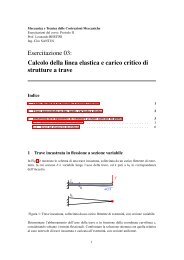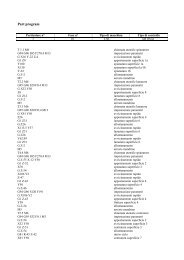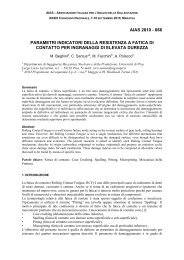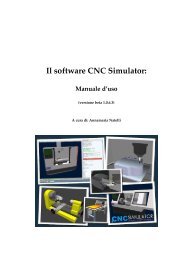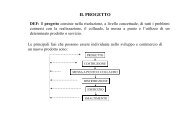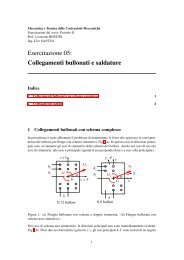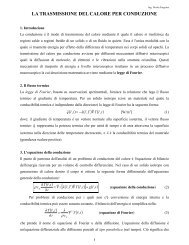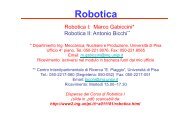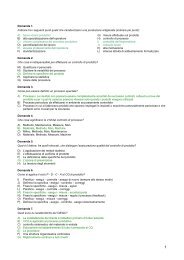Single and Two-Phase Flow Thermal Hydraulics
Single and Two-Phase Flow Thermal Hydraulics
Single and Two-Phase Flow Thermal Hydraulics
You also want an ePaper? Increase the reach of your titles
YUMPU automatically turns print PDFs into web optimized ePapers that Google loves.
Summary of the Course on<strong>Single</strong> <strong>and</strong> <strong>Two</strong>-<strong>Phase</strong> <strong>Flow</strong> <strong>Thermal</strong> <strong>Hydraulics</strong>held at University of Pisa from June 19 to 30, 2006Teacher: Prof. Walter AmbrosiniExercises by Dr. Nicola ForgioneOrganisation of LecturesThe Course has been subdivided into 8 Teaching Units which are presented with the aid of shortnotes in Word Format given to the students before the lectures <strong>and</strong> projected during teaching.In addition, five units (from E1 to E5) were used for worked out exercises, applications <strong>and</strong>demonstrations. The number of pages of documentation <strong>and</strong> the content for each lecture unit isreported hereafter.Unit 1 – Fluids <strong>and</strong> Balance Equations (31 pages)• Basic Concepts about Fluids• Fluid Models <strong>and</strong> <strong>Flow</strong> Regimes (single-phase)• Balance Equations for <strong>Single</strong>-<strong>Phase</strong> Fluidso General Conceptso Useful Mathematical Relationshipso Level of Detail in Balance Equationso Integral Lumped Parameter Equationso Partial Differential Balance Equationso Need for Closure LawsUnit 2 – Laminar <strong>Flow</strong>, Navier-Stokes Equations <strong>and</strong> Boundary Layer Phenomena (34 pages)• Basic Concepts about Laminar <strong>Flow</strong>o Newtonian <strong>and</strong> Non-Newtonian Fluidso Short Overview on Non-Newtonian Fluids• Laminar <strong>Flow</strong> of Newtonian Fluidso Navier-Stokes Equationso Dimensional Analysis of Navier-Stokes Equations• Typical Applications of Navier-Stokes Equations• Few Concepts about Rotational <strong>and</strong> Irrotational <strong>Flow</strong>s• Boundary Layer Phenomena <strong>and</strong> EquationsUnit 3 – Heat Transfer in Laminar <strong>Flow</strong> (24 pages)• Few Basic Remarks on Heat Transfer Mechanisms• <strong>Thermal</strong> Energy Balance in Terms of Temperature• Heat Transfer Problems in Laminar <strong>Flow</strong>o <strong>Thermal</strong> Boundary Layer over a Flat Plateo Heat transfer in a circular pipe with laminar flowUnit 4 – Momentum <strong>and</strong> Heat Transfer in Turbulent <strong>Flow</strong> (40 pages)• General Remarks on Turbulent <strong>Flow</strong>• Statistical Treatment of Turbulent <strong>Flow</strong>• Momentum Transfer in Turbulent <strong>Flow</strong>o Eddy Viscosityo Velocity distribution in turbulent flow1/5
o Distributed Pressure Drops <strong>and</strong> Friction Factors in Turbulent <strong>Flow</strong>o Singular Pressure Dropso Few remarks on Pump Characteristics• Heat Transfer in Turbulent <strong>Flow</strong>o Eddy Diffusivityo Reynolds Analogy for <strong>Flow</strong> on a Flat Plateo Heat Transfer in Ducts with Forced Convectiono Remarks on Heat Transfer in Free ConvectionUnit 5a – Natural Circulation in <strong>Single</strong>-<strong>Phase</strong> <strong>Flow</strong> (9 pages)Unit 5b – Notes on Compressible <strong>Single</strong>-<strong>Phase</strong> <strong>Flow</strong> (14 pages)Unit 5c – More on Turbulence (20 pages)• Length Scales in Turbulence• Direct Numerical Simulation• Large Eddy Simulation• Reynolds Averaged Navier-Stokes Equationso Algebraic Modelso One-Equation Modelso <strong>Two</strong>-Equation ModelsUnit 6 – <strong>Two</strong>-<strong>Phase</strong> <strong>Flow</strong>: General Definitions, <strong>Flow</strong> Regime Maps <strong>and</strong> Balance Equations(52 pages)• General Definitions• <strong>Flow</strong> Regimeso Main Observed Phenomenao <strong>Flow</strong> Regime Mapso <strong>Flow</strong> Regime Transition Criteria• Balance Equations for <strong>Two</strong>-<strong>Phase</strong> <strong>Flow</strong>o General Remarkso One-Dimensional Homogeneous Equilibrium Modelo One-Dimensional <strong>Two</strong>-Fluid Modelo Remarks on Balance Equations for <strong>Two</strong>-<strong>Phase</strong> <strong>Flow</strong>o Semi-empirical Approaches for Mixture Modelso Mathematical Character of Balance Equations for <strong>Two</strong>-<strong>Phase</strong> <strong>Flow</strong>Unit 7 – Pressure Drops <strong>and</strong> Heat Transfer in <strong>Two</strong>-<strong>Phase</strong> <strong>Flow</strong> (58 pages)• Pressure Drops in <strong>Two</strong>-<strong>Phase</strong> <strong>Flow</strong>o General Definitionso The Homogeneous Equilibrium modelo The Lockhart <strong>and</strong> Martinelli Modelo The Martinelli-Nelson Modelo Other Modelso Codes <strong>and</strong> <strong>Two</strong>-<strong>Phase</strong> Pressure Drops• Boiling Heat Transfero Conditions for the Occurrence of Boilingo Phenomenological Description of Pool Boilingo Quantitative Evaluation of Pool Boiling Phenomenao Phenomenological Description of <strong>Flow</strong> Boilingo Quantitative Evaluation of <strong>Flow</strong> Boiling Phenomena2/5
• Condensationo General Remarkso Flmwise Condensationo Effect of Noncondensable Gaseso The analogy between Heat <strong>and</strong> Mass Transfero Superposition of latent <strong>and</strong> convective heat transfer during condensationo <strong>Two</strong>-<strong>Phase</strong> Heat Transfer in CodesUnit 8 – Some Specific Phenomena in <strong>Two</strong>-<strong>Phase</strong> <strong>Flow</strong>: Critical <strong>Flow</strong>, Flooding <strong>and</strong> BoilingChannel Instabilities (30 pages)• Critical <strong>Flow</strong>o General Description of the Phenomenono Importance of the Phenomenon for Nuclear Technologyo Mathematical Explanation of the Phenomenono Reminder of Critical <strong>Flow</strong> for a Perfect Gaso <strong>Two</strong>-<strong>Phase</strong> Critical <strong>Flow</strong> Models• Floodingo Phenomenological Descriptiono Quantitative Prediction• Boiling Channel Instabilitieso Classification of Instabilitieso Static Instabilitieso Dynamic Instabilitieso Tools for Predicting Boiling InstabilitiesOrganisation of Exercises <strong>and</strong> ApplicationsExercises were proposed all along the Course subdivided into Units E1 to E5, including:1) CLASSICAL NUCLEAR REACTOR PLANT CALCULATIONSo Energy Balances <strong>and</strong> Temperature Distributions in PWRs (E3)o Energy Balances <strong>and</strong> Temperature Distributions in BWRs (E3)o Application of lumped parameter equations for large capacities in two-phase flow (E2)o Manual <strong>and</strong> automatic calculation (via a specific FORTRAN code developed by theteacher for teaching purposes) of the first pressure peak in a nuclear reactor drycontainment (E2)o Demonstration of results obtained by the ECART non equilibrium model for thedynamics of the pressurizer <strong>and</strong> a PWR blowdown. (E2)2) MATLAB <strong>and</strong> manual calculationso Steady-state <strong>and</strong> transient heat conduction calculation in a fuel rod (E1)o Steady <strong>and</strong> transient heat conduction in a flat plate (E1)o Steady heat conduction in a 2D rectangular domain (E1)3) FLUENT <strong>and</strong> other CFD codes applicationso Laminar flow <strong>and</strong> comparison with closed form solutions (E4)Plane Poiseuille flowCircular duct Poiseuille flowo Corresponding turbulent cases <strong>and</strong> comparison with power law profiles (E4)o <strong>Flow</strong> patterns in a PWR downcomer <strong>and</strong> lower plenum (E4)o Condensation in a situation similar to the CONAN apparatus installed in Pisa (E4)o General presentation of supercritical reactor concepts <strong>and</strong> demonstration of CFDcalculation for heat transfer in supercritical CO2 (E4).3/5
4) RELAP5o Natural <strong>and</strong> gas-injection enhanced circulation (ENEA CIRCE facility <strong>and</strong> ScalbatraioLaboratory facility) (E5)o Boiling channel: stability conditions (E5)5) SHORT TOUR OF FACILITIES AT THE SCALBATRAIO LABORATORYProf. Ambrosini <strong>and</strong> Dr. Nicola Forgione mainly proposed the exercises. Ing. Medhat BashirSharabi proposed some remarks on the supercritical reactor concept <strong>and</strong> the application of CFD toexperiments concerning heat transfer on supercritical CO 2 . The responsibility of the content ofexercises, demonstrations <strong>and</strong> applications is fully retained by Prof. Ambrosini.Timetable of LecturesThe actual Timetable of Lectures can be found at the site:http://131.114.190.27/cgi-bin/virmap/regibo?registri:16897570;mainIn the overall, a total of 66 teaching hours have been delivered, including 49 hours of lectures <strong>and</strong>17 hours of applications.Educational Worth of the Course in the light of EMSNEThe Course (worth 6 ECTS credit units) has been delivered with the purpose of letting the studentsmaster basic concepts, equations <strong>and</strong> correlations in single <strong>and</strong> two-phase thermal-hydraulics, withmain reference to their use in nuclear reactor technology.The phenomena occurring or envisaged to occur in the nuclear reactor have been givenattention even while proposing fundamental concepts. In this aim, examples from the field ofNuclear Engineering have been continuously proposed during lectures as well as during exercises<strong>and</strong> applications.After passing the Course, the students are supposed to possess all the basic backgroundneeded for underst<strong>and</strong>ing thermal-hydraulic plant behaviour during normal <strong>and</strong> accident conditions,as described in the Courses of Introduction to Nuclear Engineering, Nuclear Reactor Safety, etc..The demonstrations <strong>and</strong> the direct involvement of the students in the use of CFD <strong>and</strong>/orsystem codes was intended to let them be aware of the up-to-date techniques adopted in the analysisof nuclear reactor component thermal-hydraulic behaviour.Textbooks <strong>and</strong> SourcesIt must be remarked that the material provided by the teacher during the course can in no waysubstitute textbooks.It is intended that the students, after attending the lectures <strong>and</strong> reading the material proposedby the teacher, will use the suggested textbooks <strong>and</strong> the suggested readings for their preparation <strong>and</strong>formation of cultural background. Guidelines for preparing to the examination are provided by theteacher.The main suggested Textbook is:N.E. Todreas, M. S. Kazimi “Nuclear Systems I”, Taylor & Francis, 1990.Additional suggested readings have been proposed by the Teacher during the lectures. Among themthe following textbooks are quoted.4/5
For general treatments of single-phase fluid mechanic aspects• D.J. Tritton “Physical Fluid Dynamics”, Oxford Science Publications, 2 nd Edition, 1997.• R.L. Mott “Applied Fluid Mechanics”, Prentice Hall, 5 th Edition, 2000.• B.R. Munson, D.F. Young, T.H. Okiishi “Fundamentals of Fluid Mechanics”, 4 th Edition,Wiley, 2002, (with included CD-ROM).• R.B. Bird, W.E. Stuart, E.N. Lightfoot, “Transport Phenomena”, John Wiley & Sons, Inc.,1966.• W. F. Hughes <strong>and</strong> J. A. Brighton “Fluid Dynamics”, McGraw Hill, Schaum’s Outlines, 3 rdEdition, 1999.For specific single-phase heat transfer aspects• F.P. Incropera <strong>and</strong> D.P. DeWitt “Fundamentals of Heat <strong>and</strong> Mass Transfer”, 4 th Edition,1996.• Frank Kreith, Mark S. Bohn “Principles of Heat Transfer”, Thomson-Engineering, 2000.• J.H. Lienhard "A Heat Transfer Textbook", Prentice Hall, Englewood Cliffs, 1987.For summaries on turbulence modelling• D.C. Wilcox “Turbulence Modeling for CFD”, 2nd Edition, DCW Industries, 1998.• H.K. Veersteg <strong>and</strong> W. Malalasekera “An introduction to computational fluid dynamics”,Pearson, Prentice Hall, 1995.For two-phase flow <strong>and</strong> heat transfer• N.E. Todreas, M. S. Kazimi “Nuclear Systems II”, Taylor & Francis, 1990.• J. G. Collier <strong>and</strong> J.R. Thome “Convective Boiling <strong>and</strong> Condensation”, Oxford SciencePublications, 3 rd Edition, Clarendon Press, Oxford, 1999.• R.T. Lahey, Jr., F.J. Moody “The <strong>Thermal</strong>-<strong>Hydraulics</strong> of Boiling Water Nuclear Reactor”,American Nuclear Society, 2 nd Edition, 1993.• L.S. Tong, J. Weisman “<strong>Thermal</strong> Analysis of Pressurized Water Reactors”, AmericanNuclear Society, 3 rd Edition, 1996.For a better underst<strong>and</strong>ing basing on audiovisual tools• M. Van Dyke, “An Album of Fluid Motion”, The Parabolic Press, Stanford, CA, 1998.• CD-ROM attached to the text B.R. Munson, D.F. Young, T.H. Okiishi “Fundamentals ofFluid Mechanics”, 4 th Edition, Wiley, 2002,• Multimedia Fluid Mechanics, CD-ROM of Cambridge University Press.An old but still interesting general book on reactor safety <strong>and</strong> related phenomena:E.E. Lewis “Nuclear Power Reactor Safety”, John Wiley <strong>and</strong> Sons, 1977.5/5




